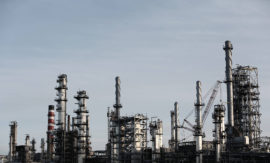Intended learning outcomes: Explain the need for using detailed production structures for long-term or master planning in chemical production.
Companies that process basic materials (basic producers) manufacture a number of different end products from relatively few raw materials. The number of end products is small, however, when compared to the number of products that are manufactured by assembly-oriented production companies. For example, in the chemical industry, part of the pharmaceutical division (formerly Ciba-Geigy) of the Novartis Group produces “only” about 150 active substances, and they are produced from just a few raw materials. There are, however, a large number of process stages, and some of these active substances have a cumulative lead time of up to two years. There are also large safety stocks in intermediate stores along the process chain. The number of different work centers that have to be scheduled corresponds roughly to the number of products and intermediate products. The number can be counted in the hundreds, but not in the thousands, if we consider all the process chains.
Experience shows that with such quantities there are no meaningful rough-cut business objects. Long-term or master planning is therefore carried out using detailed production structures (see Section 5.1.1). This is unavoidable, since resource requirements planning cannot be carried out using gross figures. Even at the long-term planning stage, the campaigns must be offset against the available capacity because, as mentioned above, a campaign cannot simply be interrupted or partly outsourced for economic reasons. This cannot happen at all for batches. In addition, with flow resources, successive processes cannot be interrupted.
Here, demand forecasts are absolutely essential, for this type of production involves stocking at the end product level. The demand for raw materials must also be derived quasi-deterministically, because the components are required block-wise, and there are limits on their use in other products. More and more companies in the process industry are faced with having to review their logistics costs, so that their stocks and lead times must also be reduced.
The loss of buffers resulting from this reduction makes any interruptions very visible, particularly if demand for the end products fluctuates greatly. Deterministic resource management models can then result in a shortfall of resources, particularly with respect to capacity. The robustness needed due to changing demand and rescheduling also asks for increased flexibility — flexible capacity in particular. Increasingly, capacity has to be adapted to demand. As a result, finite loading in the sense of comprehensive advance planning is no longer possible. It must be replaced by a greater ability to respond, that is, control in response to changing situations. Greater emphasis is thus placed on the interaction between all the people involved in production and in planning and executing the process.
Course section 8.4: Subsections and their intended learning outcomes

8.4 Special Features of Long-Term Planning
Intended learning outcomes: Disclose the determination of the degree of detail of the master production schedule. Describe pipeline planning across several independent locations.

8.4.1 Determining the Degree of Detail of the Master Production Schedule
Intended learning outcomes: Explain the need for using detailed production structures for long-term or master planning in chemical production.

8.4.2 Pipeline Planning across Several Independent Locations
Intended learning outcomes: Describe a typical production pipeline showing its production locations.

8.4.2b Master Production Scheduling (MPS) Process for Several Independent Locations
Intended learning outcomes: Explain the master production scheduling (MPS) process and the planning group for several locations that operate independently of one another.
